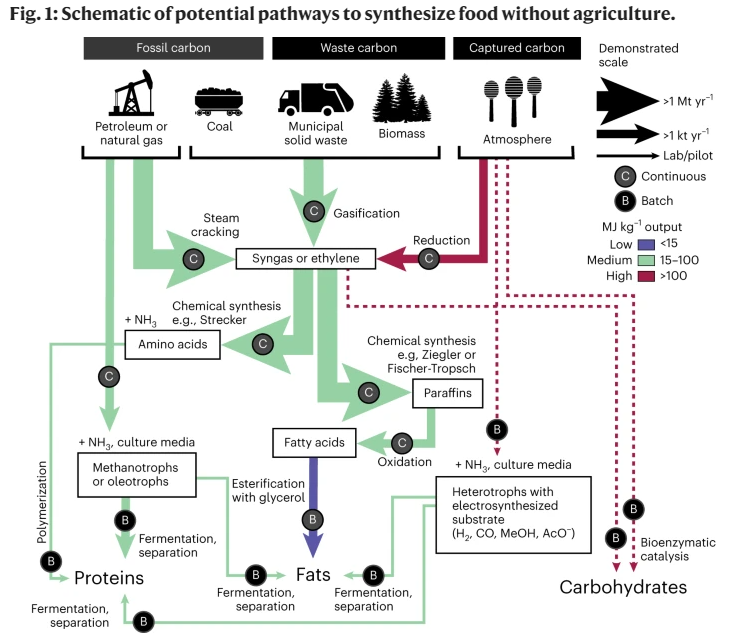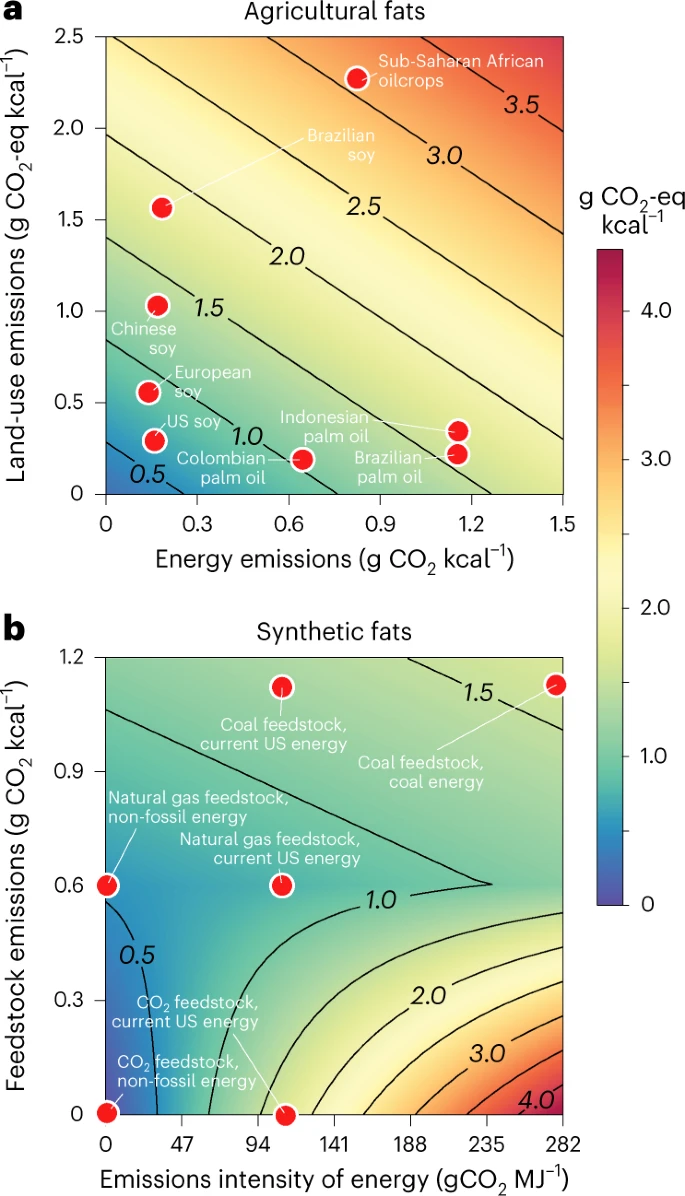
This paper considers the potential for synthetically (without agricultural) produced dietary fats to reduce the impact that global diets have on the environment. The paper explores potential inputs for this process, and compares the greenhouse gas and land use emissions saving of scaling various synthetic fat production models compared with organically produced fats.
Summary
It is widely agreed that global food production needs to reduce its use of land, water and fossil fuels, as well as its greenhouse gas emissions. This paper highlights the possibility of supplementing diets with synthesised fats; where food is made from a feedstock of carbon from non-organic resources such as fossil fuels, waste and atmospheric carbon. The authors focused on fats (as opposed to proteins of carbohydrates) because they are a relatively simple nutrient to synthesise (compatible with large-scale soap-making), they have previously been synthesised at scale during WWII, fats are used interchangeably with little regard for flavour or properties (eg. palm oil, soy, canola) and oil crops such as soy and palm have enormous environmental impacts. This paper introduces a range of inputs for synthetic fats and estimates the life cycle energy use, greenhouse gas emissions and land use in comparison with organic dietary fats using 100-yr global warming potentials, including legacy land-use-change emissions. The authors acknowledge the potential for positive contributions in other fields (eg. water), but these are out of scope for this paper.
Syngas (a mixture of H2 and CO) and ethylene (C2H4) are produced from fossil fuels and organic wastes at a scale of >1 Mt yr−1. Syngas and ethylene can then be converted by processes such as Ziegler or Fischer-Tropsch to paraffins, fatty acids and fats. Biological pathways to fats also exist. Fat has been produced from atmospheric carbon via fermentation of electrosynthetic intermediates, including hydrogen and acetate. A full list of pathways to synthesising food without agriculture can be seen in figure 1.

Figure 1: Pathways to synthesising food without agriculture
The authors estimate that depending on crop, sourcing and associated land-use emissions, GHG emissions per kilocalorie of fats produced in agriculture range from <1.0 g CO2-eq kcal−1 (for example, soybeans grown in the United States and Europe) to >3 g CO2-eq kcal−1 (for example, palm oil grown in Africa). In comparison, they estimate that synthesised fats from fossil fuels using energy with the carbon intensity of current average US electricity would produce ~0.8 g CO2-eq kcal−1, and at the extreme, net zero emissions if using carbon capture technologies and renewable energy. Estimates are visualised in figure 2, which the authors note illustrates (figure 2b) a distinction between synthetic fats produced from feedstocks containing internal energy, such as CH4, and those without, such as CO2 (in the latter case (corresponding to the bottom half of figure 2b). The process of breaking the bonds that make up methane to create synthetic fats release energy that can be used to fuel the process, this is not the case for CO2. Therefore, the emissions intensity of the synthetic fats has a very strong dependence on the emissions intensity of the sourced electricity, while emissions for fossil-derived synthetic fats (corresponding to the top half of Fig. 2b) are dominated by the feedstock source. The emissions intensity of the synthetic fats has a very strong dependence on the emissions intensity of the sourced electricity, while emissions for fossil-derived synthetic fats are dominated by the feedstock source. Comparing land area per kilocalorie, agricultural fats produce 15–20 million kcal per hectare per year whilst synthetic fats produce >1 billion kcal per hectare per year.

Figure 2: Comparison of emissions per calorie of edible fats.
The authors conclude that substantial GHG emissions and land use could be avoided through synthesised dietary fats, meeting increasing global demand for dietary fats whilst making climate-relevant quantities of emissions savings. They also note additional potential benefits out of scope of the paper, including reduced water use, decreased air and water pollution, improved food security and food sovereignty, resistance to some global catastrophe scenarios, less need for low-paying and physically demanding agricultural labour, and vast tracts of land made available for reforestation, with attendant benefits for biodiversity and natural carbon sinks. However they note the following limitations:
- Calculations were made at national scale and may therefore not capture geographical, process-level and scale-dependent details or projected future changes that could be relevant in quantifying potential environmental benefits
- The cost of large-scale fat synthesis is a barrier, especially if the environmental costs of agriculture continue to be externalised, making agriculture fats incredibly cheap.
- Social acceptance may be difficult: the combination of chemistry and food has a troubled history (eg. pesticides, preservatives, artificial foods) that may be difficult to overcome.
- There will be negative impacts on work, especially the displacement of agriculture labour force in the global south, where agriculture is a major sector of the economy. A just transition approach would be necessary.
Abstract
Efforts to make food systems more sustainable have emphasized reducing adverse environmental impacts of agriculture. In contrast, chemical and biological processes that could produce food without agriculture have received comparatively little attention or resources. Although there is a possibility that someday a wide array of attractive foods could be produced chemosynthetically, here we show that dietary fats could be synthesized with <0.8 g CO2-eq kcal−1, which is much less than the >1.5 g CO2-eq kcal−1 now emitted to produce palm oil in Brazil or Indonesia. Although scaling up such synthesis could disrupt agricultural economies and depend on consumer acceptance, the enormous potential reductions in greenhouse gas emissions as well as in land and water use represent a realistic possibility for mitigating the environmental footprint of agriculture over the coming decade.
Reference
Davis, S.J., Alexander, K., Moreno-Cruz, J., Hong, C., Shaner, M., Caldeira, K. and McKay, I., 2023. Food without agriculture. Nature Sustainability, pp.1-6.
Read the article here and for more on future food see Meat: The Four Futures







Post a new comment »